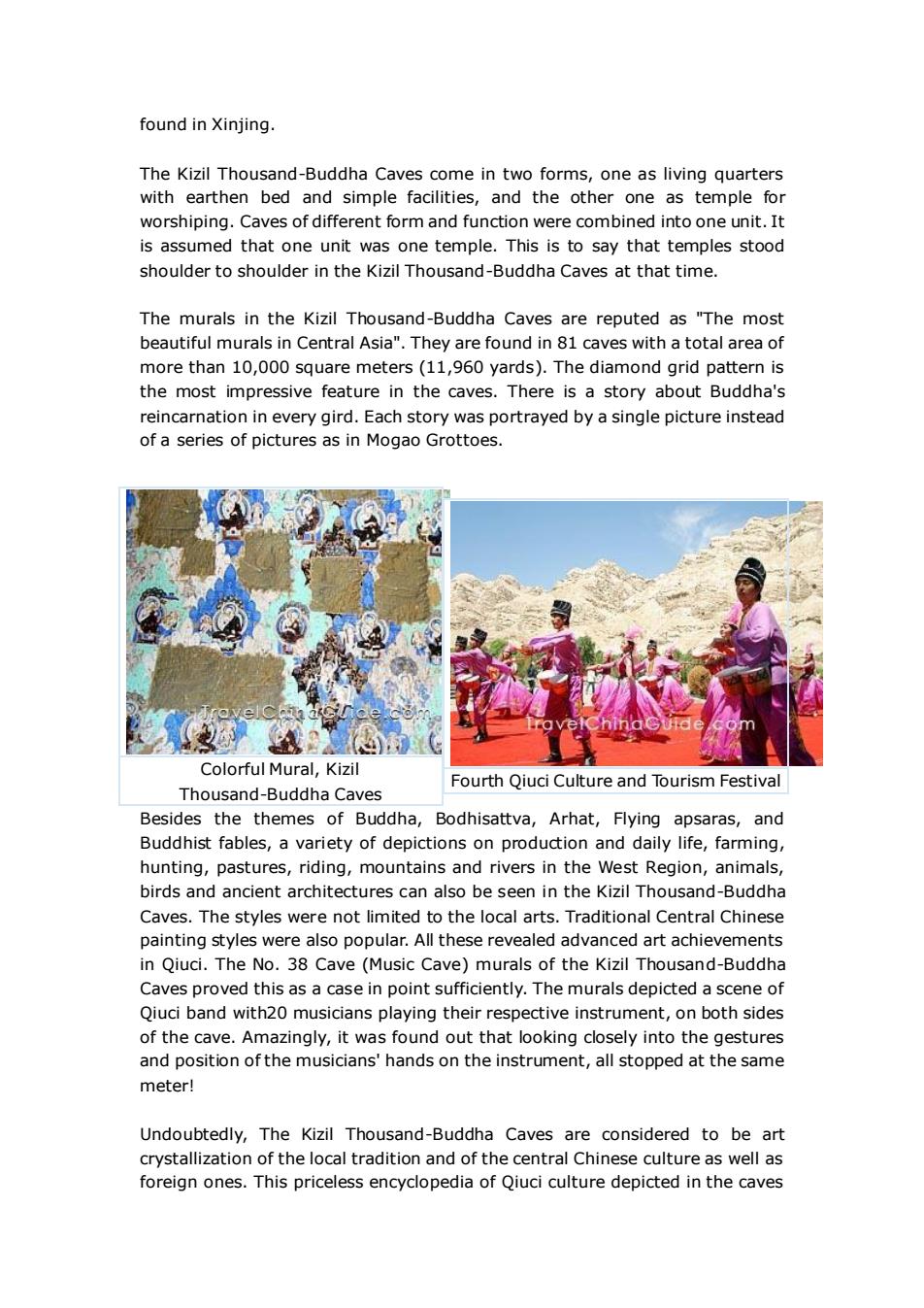正在加载图片...

found in Xinjing. with earthen s come in two forms,one as living quarters one as temple for worshiping.Caves of different form and function were combined into one unit.It is assumed that one unit was one temple.This is to say that temples stood shoulder to shoulder in the Kizil Thousand-Buddha Caves at that time. The murals in the Kizil Thousand-Buddha Caves are reputed as"The most beautiful murals in Central Asia".They are found in 81 caves with a total area of more than 10,000 square meters(11,960 yards).The diamond grid pattern is the most impressive feature in the caves.There is a story about Buddha's every gird.Each story was portrayed by a single picture instead Colorful Mural,Kizil Thousand-BuddhaCaves Fourth Qiuci Culture and Tourism Festival Besid the themes of Buddha,Bodhisattva,Arhat,Flying apsaras,and Buddhist fables,a variety of depictions on production and daily life,farming, hunting,pastures,riding,mountains and rivers in the West Region,animals, birds and ancient architectures can also be seen in the kizil thousand-Buddha The styles were not limited to the local rts.Traditional Central Chine painting styles were also popula All these reveale dvanced art achie ements in Qiuci.The No.38 Cave (Music Cave)murals of the Kizil Thousand-Buddha Caves proved this as a case in point sufficiently.The murals depicted a scene of Qiuci band with20 musicians playing their respective instrument,on both sides of the cave.Amazingly,it was fo d out that looking closely into the gestures and position f the mu sicians'han n the instrument,all stopped at the meter! Undoubtedly,The Kizil Thousand-Buddha Caves are considered to be art crystallization of the local tradition and of the central Chinese culture as well as foreign ones.This priceles encyclopedia of Qiuci culture depicted in the caves found in Xinjing. The Kizil Thousand-Buddha Caves come in two forms, one as living quarters with earthen bed and simple facilities, and the other one as temple for worshiping. Caves of different form and function were combined into one unit. It is assumed that one unit was one temple. This is to say that temples stood shoulder to shoulder in the Kizil Thousand-Buddha Caves at that time. The murals in the Kizil Thousand-Buddha Caves are reputed as "The most beautiful murals in Central Asia". They are found in 81 caves with a total area of more than 10,000 square meters (11,960 yards). The diamond grid pattern is the most impressive feature in the caves. There is a story about Buddha's reincarnation in every gird. Each story was portrayed by a single picture instead of a series of pictures as in Mogao Grottoes. Colorful Mural, Kizil Thousand-Buddha Caves Fourth Qiuci Culture and Tourism Festival Besides the themes of Buddha, Bodhisattva, Arhat, Flying apsaras, and Buddhist fables, a variety of depictions on production and daily life, farming, hunting, pastures, riding, mountains and rivers in the West Region, animals, birds and ancient architectures can also be seen in the Kizil Thousand-Buddha Caves. The styles were not limited to the local arts. Traditional Central Chinese painting styles were also popular. All these revealed advanced art achievements in Qiuci. The No. 38 Cave (Music Cave) murals of the Kizil Thousand-Buddha Caves proved this as a case in point sufficiently. The murals depicted a scene of Qiuci band with20 musicians playing their respective instrument, on both sides of the cave. Amazingly, it was found out that looking closely into the gestures and position of the musicians' hands on the instrument, all stopped at the same meter! Undoubtedly, The Kizil Thousand-Buddha Caves are considered to be art crystallization of the local tradition and of the central Chinese culture as well as foreign ones. This priceless encyclopedia of Qiuci culture depicted in the caves